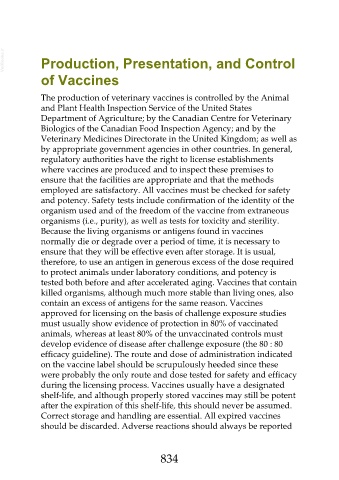Page 834 - Veterinary Immunology, 10th Edition
P. 834
VetBooks.ir Production, Presentation, and Control
of Vaccines
The production of veterinary vaccines is controlled by the Animal
and Plant Health Inspection Service of the United States
Department of Agriculture; by the Canadian Centre for Veterinary
Biologics of the Canadian Food Inspection Agency; and by the
Veterinary Medicines Directorate in the United Kingdom; as well as
by appropriate government agencies in other countries. In general,
regulatory authorities have the right to license establishments
where vaccines are produced and to inspect these premises to
ensure that the facilities are appropriate and that the methods
employed are satisfactory. All vaccines must be checked for safety
and potency. Safety tests include confirmation of the identity of the
organism used and of the freedom of the vaccine from extraneous
organisms (i.e., purity), as well as tests for toxicity and sterility.
Because the living organisms or antigens found in vaccines
normally die or degrade over a period of time, it is necessary to
ensure that they will be effective even after storage. It is usual,
therefore, to use an antigen in generous excess of the dose required
to protect animals under laboratory conditions, and potency is
tested both before and after accelerated aging. Vaccines that contain
killed organisms, although much more stable than living ones, also
contain an excess of antigens for the same reason. Vaccines
approved for licensing on the basis of challenge exposure studies
must usually show evidence of protection in 80% of vaccinated
animals, whereas at least 80% of the unvaccinated controls must
develop evidence of disease after challenge exposure (the 80 : 80
efficacy guideline). The route and dose of administration indicated
on the vaccine label should be scrupulously heeded since these
were probably the only route and dose tested for safety and efficacy
during the licensing process. Vaccines usually have a designated
shelf-life, and although properly stored vaccines may still be potent
after the expiration of this shelf-life, this should never be assumed.
Correct storage and handling are essential. All expired vaccines
should be discarded. Adverse reactions should always be reported
834

